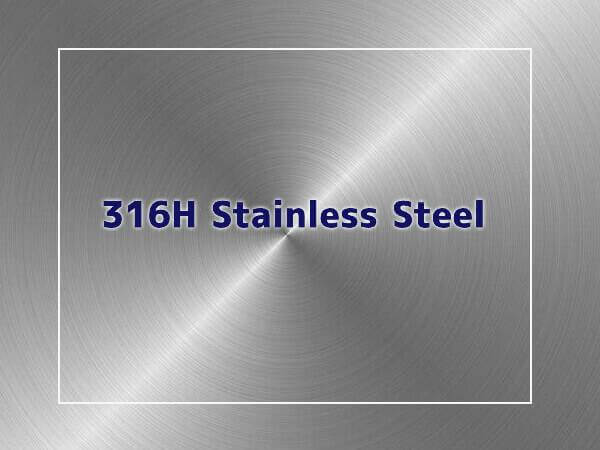
316H stainless steel is a higher carbon version of 316 type, it is a variant of 316, 316H has between 0.04 and 0.1% carbon content making it suitable for use in elevated temperatures applications, its high-temperature resistance can reach 1200-1300 degrees, and the expanded carbon content gives greater tensile and yield strength, 316H possesses the Austenitic structure enables to obtain excellent toughness, even down to low temperatures.
The corrosion resistance of Alloy 316H is comparable to Alloy 316/316L and superior to Alloy 304/304L in moderately corrosive environments. It is commonly used in process streams containing chlorides or halides. The alloy is resistant to atmospheric corrosion as well as moderate oxidizing and reducing environments. It also resists corrosion in contaminated marine conditions.
Alloy 316H is non-magnetic in the annealed condition. It cannot be hardened by heat treatment, but the material will harden by cold working. It can be easily welded and machined through standard fabrication practices, Density of 316H is 7.98 g/cm³.
316H Stainless Steel Composition
The chemical composition of stainless steel 316H is generally composed of 16 to 18% chromium, 10 to 14% nickel, 2 to 3% molybdenum, and a percentage of 0.04 to 0.10% carbon, improving its thermal stability and creep resistance. However, due to the high carbon content, it is prone to sensitization which makes welding joints vulnerable to corrosion.
| Grade | C | Si | Mn | P | S | Cr | Mo | Ni |
|---|---|---|---|---|---|---|---|---|
| 316H | 0.04 – 0.10 | 0.75 | 2.00 | 0.045 | 0.030 | 16.00 – 18.00 | 2.00 – 3.00 | 10.00 – 14.00 |
316H Stainless Steel Mechanical Properties
- Tensile Strength: 75 ksi (515 MPa)
- Yield Strength: 30 ksi (205 MPa)
- Elongation: 40%
- Hardness: 95 HRB (217 HB)
316H Stainless Steel Equivalent
- UNS S31609
- JIS SUS 316H
- DIN 1.4436
- GB 07Cr17Ni12Mo2
316H Stainless Steel Characteristics
- Higher carbon content
- Greater tensile yield strength
- Easy to machine and weld for complex manufacturing processes.
- Maybe fragile to carbide precipitation when welding
- Greater short and long-term creep strength
- Exhibits good oxidation resistance at high temperatures and is suitable for applications such as boilers, heat exchangers and catalytic converters.
- Excellent corrosion resistance, especially in acidic environments.
Forms Available
316, 316L, 316H, 316Ti Differences
316 is a basic molybdenum-based grade, 316L, 316H, and 316Ti are variant grades, and they all belong to Austenitic stainless steel.
Stainless Steel Grade 316L is a low-carbon variant of 316 and has similar properties to 316 type and better resistance to intergranular corrosion. Stainless Steel 316Ti is Titanium addition of 316 steel, the added Titanium increases corrosion resistance, enhances resistance to pitting chloride ion solutions, and gives expanded strength at high temperatures, 316H can be also used in high temperatures, but it is vulnerable, 316Ti may avoid that situation.
Chemical composition comparison
| Grade | C (Max) | Si (Max) | P (Max) | S (Max) | Mn (Max) | Cr | Ni | Mo |
|---|---|---|---|---|---|---|---|---|
| 316 | 0.08 | 0.75 | 0.045 | 0.030 | 2.0 | 16.0-18.0 | 10.0-14.0 | 2.0-3.0 |
| 316L | 0.03 | 0.75 | 0.045 | 0.030 | 2.0 | 16.0-18.0 | 10.0-14.0 | 2.0-3.0 |
| 316H | 0.04-0.10 | 0.75 | 0.045 | 0.030 | 2.0 | 16.0-18.0 | 10.0-14.0 | 2.0-3.0 |
| 316Ti | 0.08 | 1.0 | 0.040 | 0.030 | 2.0 | 16.0-18.0 | 10.0-14.0 | 2.0-3.0 |
Mechanical properties comparison
| Grade | Tensile Strength (Ksi) | 0.2% Yield Strength (Ksi) | Elongation% In 2 Inches |
|---|---|---|---|
| 316 / 316H / 316Ti | 75 | 30 | 40 |
| 316L | 70 | 25 | 40 |
Applications
- Chemical equipment: due to its corrosion resistance and high-temperature strength, 316H is commonly used in the manufacture of chemical equipment, including reactors, distillation towers, reactors and so on.
- Oil and gas industry: In oil and gas processing, 316H stainless steel can be used in the manufacture of pipelines, valves, tanks and other equipment to cope with corrosive media and high-temperature environments.
- Nuclear power plant: as one of the materials for key components in nuclear power plants, 316H stainless steel is widely used in nuclear reactor pressure vessels, heat exchangers, piping systems and so on.
- Chemical processing: in the chemical industry, 316H stainless steel is often chosen to manufacture chemical reactors, evaporators, extractors and other equipment that need to withstand corrosive media and high temperatures.
